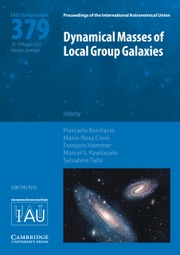Article contents
Fundamental stellar properties from asteroseismology
Published online by Cambridge University Press: 06 January 2014
Abstract
Accurate characterization of stellar populations is of prime importance to correctly understand the formation and evolution process of our Galaxy. The field of asteroseismology has been particularly successful in such an endeavor providing fundamental parameters for large samples of stars in different evolutionary phases. We present our results on determinations of masses, radii, and distances of stars in the CoRoT and Kepler fields, showing that we can map and date different regions of the galactic disk and distinguish gradients in the distribution of stellar properties at different heights. We further review how asteroseismic determinations can produce a unique set of constraints, including ages, outside the solar neighborhood for galactic chemical evolution models.
- Type
- Contributed Papers
- Information
- Proceedings of the International Astronomical Union , Volume 9 , Symposium S298: Setting the scene for Gaia and LAMOST , May 2013 , pp. 375 - 380
- Copyright
- Copyright © International Astronomical Union 2014
References
- 1
- Cited by




